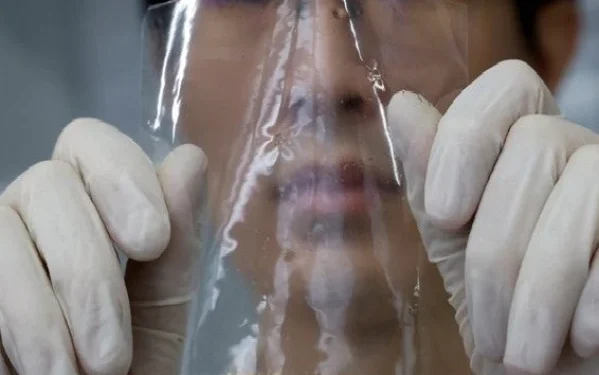In a groundbreaking advancement in environmental science, Japanese researchers have developed a new type of eco-friendly plastic that dissolves completely in seawater within just a few hours—without leaving behind harmful microplastics or toxic residues. This development could mark a pivotal turning point in the global fight against marine plastic pollution, which has emerged as one of the most pressing ecological issues of the 21st century.
A Sustainable Solution to Marine Plastic Waste
The innovation comes at a time when the world is desperately seeking sustainable alternatives to conventional petroleum-based plastics, which are notorious for their persistence in the environment and contribution to ocean pollution.
Traditional plastics can linger in the environment for hundreds of years, slowly degrading into microplastics that are consumed by marine life and eventually enter the human food chain. In contrast, this Japanese-engineered plastic breaks the cycle by completely dissolving in salt water within an hour—a feature demonstrated during experimental trials in the city of Wako, near Tokyo.
What Makes This Plastic Unique?
Dissolves Completely in Seawater
One of the most impressive characteristics of this new plastic is its ability to dissolve entirely in seawater without leaving behind microplastics. The material disintegrates within an hour of exposure to salt water, a rate that is exponentially faster than any conventional biodegradable plastic currently in use.
Unlike other so-called “biodegradable plastics” that still leave behind microscopic polymer fragments, this plastic breaks down into basic components that are readily consumed by natural marine bacteria, posing zero threat to aquatic ecosystems.
Earth-Friendly Composition
The plastic is composed of two key ionic monomers:
- Sodium hexametaphosphate
- Guanidinium ion-based monomers
When these monomers bond, they form “salt bridges,” which contribute to the strength and flexibility of the plastic. However, in the presence of salt water, these ionic bonds are disrupted, causing the material to dissolve swiftly.
This makes the plastic uniquely strong under normal conditions, yet highly degradable in marine environments.
Environmental Impact and Soil Benefits
Safe for Land and Sea
In addition to being marine-safe, the plastic is also designed to decompose in soil. On land, it fully dissolves within 10 days, turning into harmless organic compounds. Even more remarkably, during its decomposition, it releases essential nutrients like phosphorus and nitrogen, which can be absorbed by the soil, effectively acting as a natural fertilizer.
This means the material not only avoids harming the environment—it may actually enrich it.
Non-Toxic and Non-Flammable
The plastic’s composition is non-toxic, non-flammable, and carbon-neutral. Unlike traditional plastics, which can release volatile organic compounds (VOCs) or carbon dioxide during decomposition or incineration, this material breaks down without emitting greenhouse gases, making it a climate-friendly alternative.
The Science Behind It: How Salt Bridges Work
The strength of this plastic lies in the electrostatic interactions between the positively charged guanidinium ions and the negatively charged phosphate groups in sodium hexametaphosphate. These interactions form what scientists refer to as “salt bridges,” giving the plastic mechanical durability similar to that of traditional petrochemical plastics.
However, in the presence of seawater, the high ionic concentration of sodium and chloride ions interferes with these electrostatic bonds, effectively breaking the salt bridges and triggering the dissolution of the material.
This scientific mechanism ensures that the plastic remains durable in dry or freshwater environments but breaks down immediately in oceanic conditions, providing a built-in environmental safeguard.
A Global Crisis: Plastic Waste in the Oceans
The Scope of the Problem
The world produces over 430 million tons of plastic each year, a significant portion of which ends up in the oceans. According to the United Nations Environment Programme (UNEP), around 11 million tons of plastic enter the oceans annually—a number that could triple by 2040 if drastic measures are not taken.
Much of this waste originates from single-use plastics, such as:
- Food packaging
- Plastic bags
- Straws and cutlery
- Beverage bottles
These items often escape recycling systems and find their way into rivers, estuaries, and eventually the open ocean.
Impact on Marine Life and Human Health
Once in the marine ecosystem, plastics wreak havoc on marine organisms. Sea turtles, whales, and seabirds often ingest plastic debris, mistaking it for food. Microplastics are now found in over 114 aquatic species, some of which are directly consumed by humans.
Furthermore, toxic additives in plastics—including phthalates, bisphenol A (BPA), and heavy metals—can leach into seawater, affecting marine biodiversity and accumulating in the food chain.
Why This Innovation Matters
Biodegradability Meets Functionality
Many existing biodegradable plastics are either:
- Not truly biodegradable in marine conditions
- Too weak to be used in practical applications
- Require industrial composting facilities to decompose
This new Japanese invention solves all these problems by offering:
- Durability and flexibility under normal conditions
- Rapid biodegradation in seawater
- Non-toxic decomposition with beneficial by-products
A Path Toward a Circular Economy
The plastic could be a key component in transitioning to a circular economy, where materials are:
- Designed for reuse or biodegradation
- Non-toxic to humans and the environment
- Produced using sustainable chemical processes
By returning valuable nutrients to the soil and eliminating ocean waste, this plastic aligns with UN Sustainable Development Goals (SDGs), especially those related to responsible consumption (SDG 12) and life below water (SDG 14).
Challenges and Next Steps
Scaling Production
One major challenge remains: scaling production to meet industrial demand. While the lab-based demonstration is promising, manufacturing this plastic at a commercial scale will require:
- Cost-effective sourcing of monomers
- Infrastructure to process and mold the material
- Collaboration with packaging and logistics industries
Regulatory Approvals and Market Adoption
The material must also undergo regulatory approvals for use in food packaging, agriculture, and consumer goods. Public awareness and demand for eco-friendly alternatives are growing, but industry standards and compliance protocols must catch up.
Ongoing Research
Researchers are now exploring ways to enhance:
- Shelf-life under extreme temperatures
- Compatibility with other biodegradable materials
- Economic feasibility for low-income nations
If successful, this plastic could soon be used in a wide range of applications, from disposable packaging to agricultural films, and even in marine-based products like fishing nets and buoys.
Conclusion: A New Era of Plastic Sustainability
The Japanese development of a plastic that dissolves in the ocean represents a monumental leap in materials science and environmental engineering. It offers a viable solution to the problem of plastic waste in our oceans and sets the stage for the next generation of sustainable materials.
As governments, companies, and individuals seek to reduce their environmental footprints, such innovative eco-plastics will play a crucial role in achieving a cleaner, greener planet. While challenges remain in mass adoption, the science is clear: plastic doesn’t have to pollute. With innovations like this, it can help restore and regenerate our ecosystems instead.

























